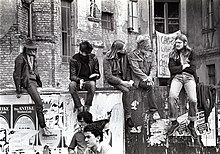Repairs
A maintenance occupation called in Germany a squat with the declared aim of decaying old buildings , apartments and save even commercial facilities from demolition and to make them habitable again.
In the process, the repair workers often encountered targeted destruction of the building fabric, the purpose of which was to prevent further use of the building - also to ruin better-preserved buildings and thus justify the demolition of entire blocks of houses. Due to the extensive self-work required, it was possible to demonstrate an extraordinary interest in preservation and thus often bring about legalization. The term was coined in 1979 in West Berlin , where a wave of squatting from 1980 onwards led to the abandonment of area renovation towards cautious urban renewal in cooperation with the International Building Exhibition 1984/87 (IBA) and through support from the population, institutions and authorities , marked.
However, not all squatters had the energy or the ability to repair them. In some cases it was spoken of broken occupation or abandonment . The house at Oranienstrasse 198 in Berlin SO 36 was controversial for a long time. As a corner house ("Besetz-A-Eck") on Heinrichplatz, it played an important role in blocking the "deforestation" on the area of Block 104:
The occupiers were considered "real 'dropouts', hopelessly stranded" - a description by the later renovator Stattbau about living in the "ruin" demolished by construction crews:
“The only thing that worked was what the squatters had installed in a makeshift manner: garden hoses were used for the water supply, loose electrical cables were pulled across the stairwell, which not only had the handrail but also the stairs. There was only one functioning 'podium toilet' per staircase, exposed beams next to the stove gave a view into the depths - the 'perspective' was left over from a quickly broken attempt to combat dry rot. [...] In spite of all this, the house was 'fully' inhabited. Thirty people lived here. "
After numerous searches of the house by the police and an evacuation followed by a tent camp shortly before the officially sanctioned start of renovation, the occupiers were able to return and with a new form of determination they took the opportunity to do so with the alternative renovation agency and numerous other supporters To rebuild the house as it were:
“Together with 'Stattbau' and the architecture faculty of the Technical University, supported by STERN and many individuals, the residents developed a new usage concept for large communal apartments and loft conversions [...] on their own. At the initiative of 'Stattbau', most of the residents were employed in a project that was covered by Paragraph 19.1. of the Federal Social Welfare Act ('Help for Work') and ABM funds. The house was transferred to the 'Genossenschaft Luisenstadt eG' in 1986. "
Detailed in: Block 104
The rainbow factory Berlin in Berlin-Kreuzberg is an example of a successful recruitment with a long-term perspective .
The Hamburg Gängeviertel "Valentinskamp" is a more up-to-date maintenance team .
The derived word repair squatters in 1980 by the Society for the German Language in the election for Word of the Year voted into third place.
literature
- Reinhild Kreis : DIY as a protest. Repair occupants and housing policy in West Berlin during the 1980s , in: Zeithistorische Forschungen 14 (2017), pp. 41–67.
- Florian von Buttlar, Stefanie Finally: Lenné in the backyard. The story of a Berlin block of flats , publisher: Deutscher Werkbund Berlin eV in collaboration with the STERN Society of Cautious Urban Renewal, Transit Buchverlag, Berlin 1989.
- Ed .: Stattbau Stadtentwicklungs GmbH: Stattbau informs , Volume 2, Stattbau and October printing , Berlin 1984. ISBN 3-924536-00-7 .
Web links
Individual evidence
- ^ Anne Schöning: Oranienstrasse 198 in Kreuzberg. A residential and employment project in block 104 , documentation, publisher: STATTBAU, Berlin December 1995, p. 4.
- ↑ Florian von Buttlar, Stefanie Endlich: Lenné in the backyard. The story of a Berlin block of flats , publisher: Deutscher Werkbund Berlin eV in cooperation with the STERN Society of careful urban renewal mbH, Transit Buchverlag, Berlin 1989, p. 45.
- ↑ Sven Stillich, Iris Hellmuth: Squatters in Hamburg: The city - who is that? In: fr-online.de . October 1, 2009, accessed December 29, 2014 .
- ↑ Word of the Year. In: gfds.de. Society for the German Language, accessed on December 29, 2014 .



